[SOLVED] JB HiFi Ltd Investment Analysis
VerifiedAdded on 2020/10/22
|14
|1986
|372
AI Summary
This assignment involves analyzing a proposed investment for JB HiFi Ltd using various financial metrics such as net present value (NPV), payback period, average rate of return (ARR), and profitability index (PI). The security market line is also calculated to determine the cost of equity. Based on these calculations, it is determined whether JB HiFi should accept or reject the proposed investment.
Contribute Materials
Your contribution can guide someone’s learning journey. Share your
documents today.
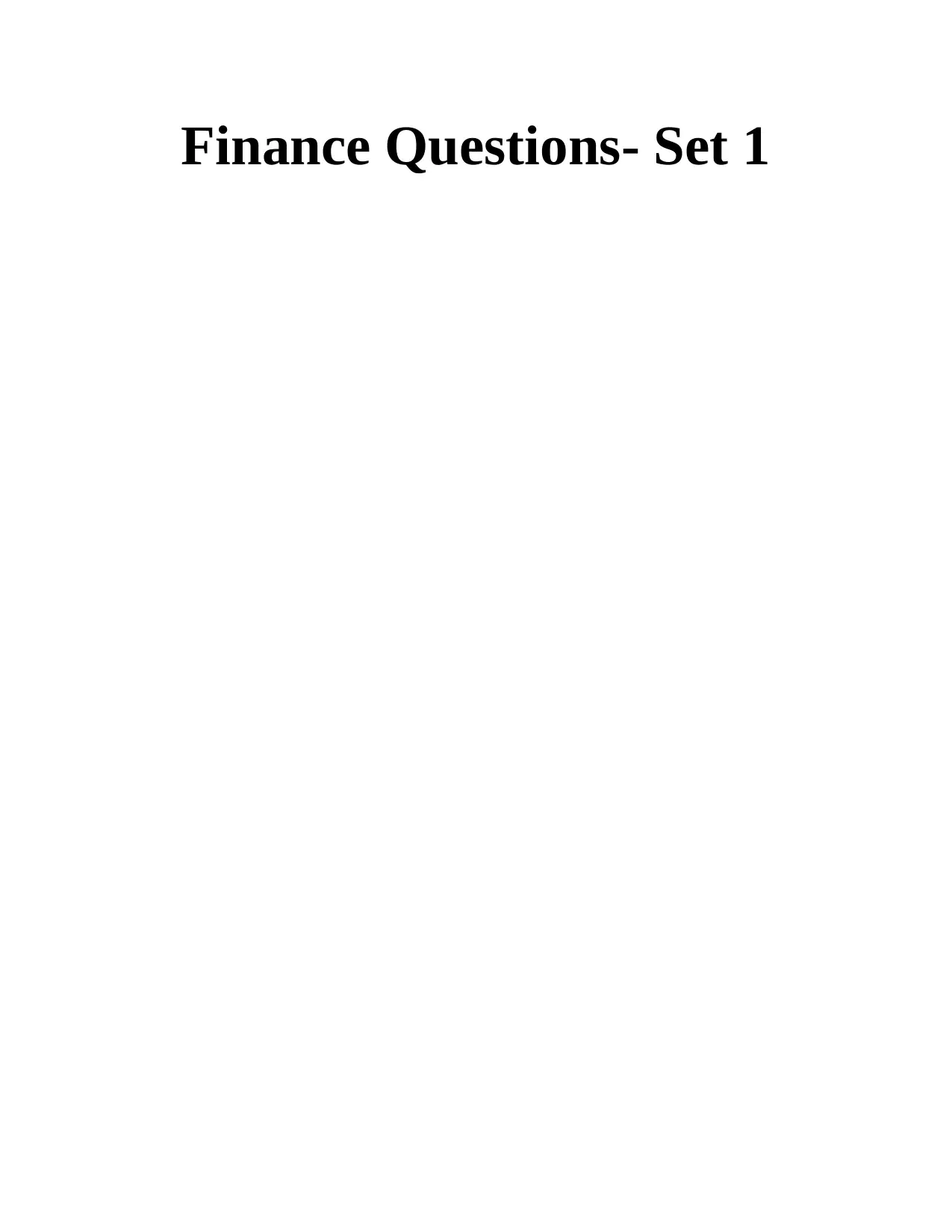
Finance Questions- Set 1
Secure Best Marks with AI Grader
Need help grading? Try our AI Grader for instant feedback on your assignments.
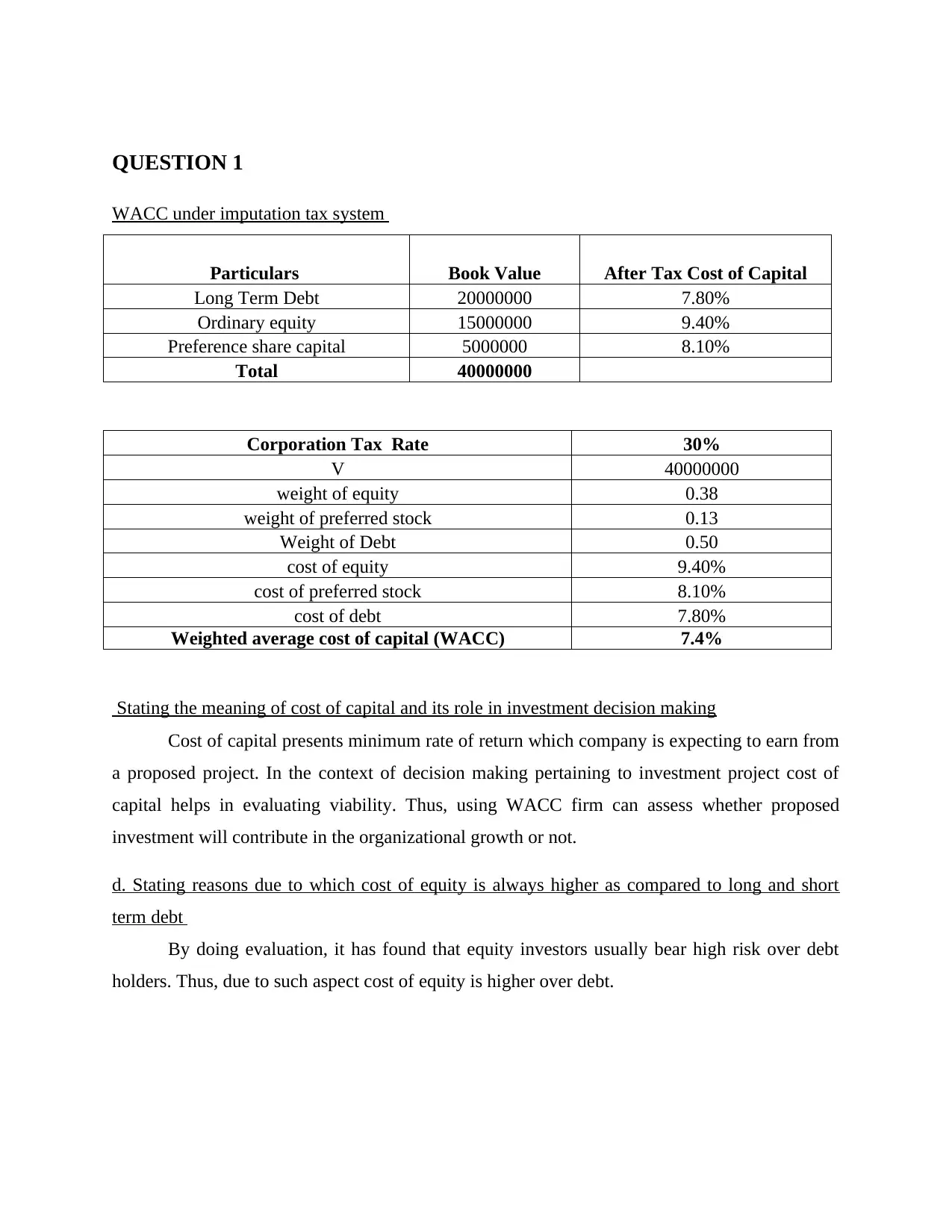
QUESTION 1
WACC under imputation tax system
Particulars Book Value After Tax Cost of Capital
Long Term Debt 20000000 7.80%
Ordinary equity 15000000 9.40%
Preference share capital 5000000 8.10%
Total 40000000
Corporation Tax Rate 30%
V 40000000
weight of equity 0.38
weight of preferred stock 0.13
Weight of Debt 0.50
cost of equity 9.40%
cost of preferred stock 8.10%
cost of debt 7.80%
Weighted average cost of capital (WACC) 7.4%
Stating the meaning of cost of capital and its role in investment decision making
Cost of capital presents minimum rate of return which company is expecting to earn from
a proposed project. In the context of decision making pertaining to investment project cost of
capital helps in evaluating viability. Thus, using WACC firm can assess whether proposed
investment will contribute in the organizational growth or not.
d. Stating reasons due to which cost of equity is always higher as compared to long and short
term debt
By doing evaluation, it has found that equity investors usually bear high risk over debt
holders. Thus, due to such aspect cost of equity is higher over debt.
WACC under imputation tax system
Particulars Book Value After Tax Cost of Capital
Long Term Debt 20000000 7.80%
Ordinary equity 15000000 9.40%
Preference share capital 5000000 8.10%
Total 40000000
Corporation Tax Rate 30%
V 40000000
weight of equity 0.38
weight of preferred stock 0.13
Weight of Debt 0.50
cost of equity 9.40%
cost of preferred stock 8.10%
cost of debt 7.80%
Weighted average cost of capital (WACC) 7.4%
Stating the meaning of cost of capital and its role in investment decision making
Cost of capital presents minimum rate of return which company is expecting to earn from
a proposed project. In the context of decision making pertaining to investment project cost of
capital helps in evaluating viability. Thus, using WACC firm can assess whether proposed
investment will contribute in the organizational growth or not.
d. Stating reasons due to which cost of equity is always higher as compared to long and short
term debt
By doing evaluation, it has found that equity investors usually bear high risk over debt
holders. Thus, due to such aspect cost of equity is higher over debt.
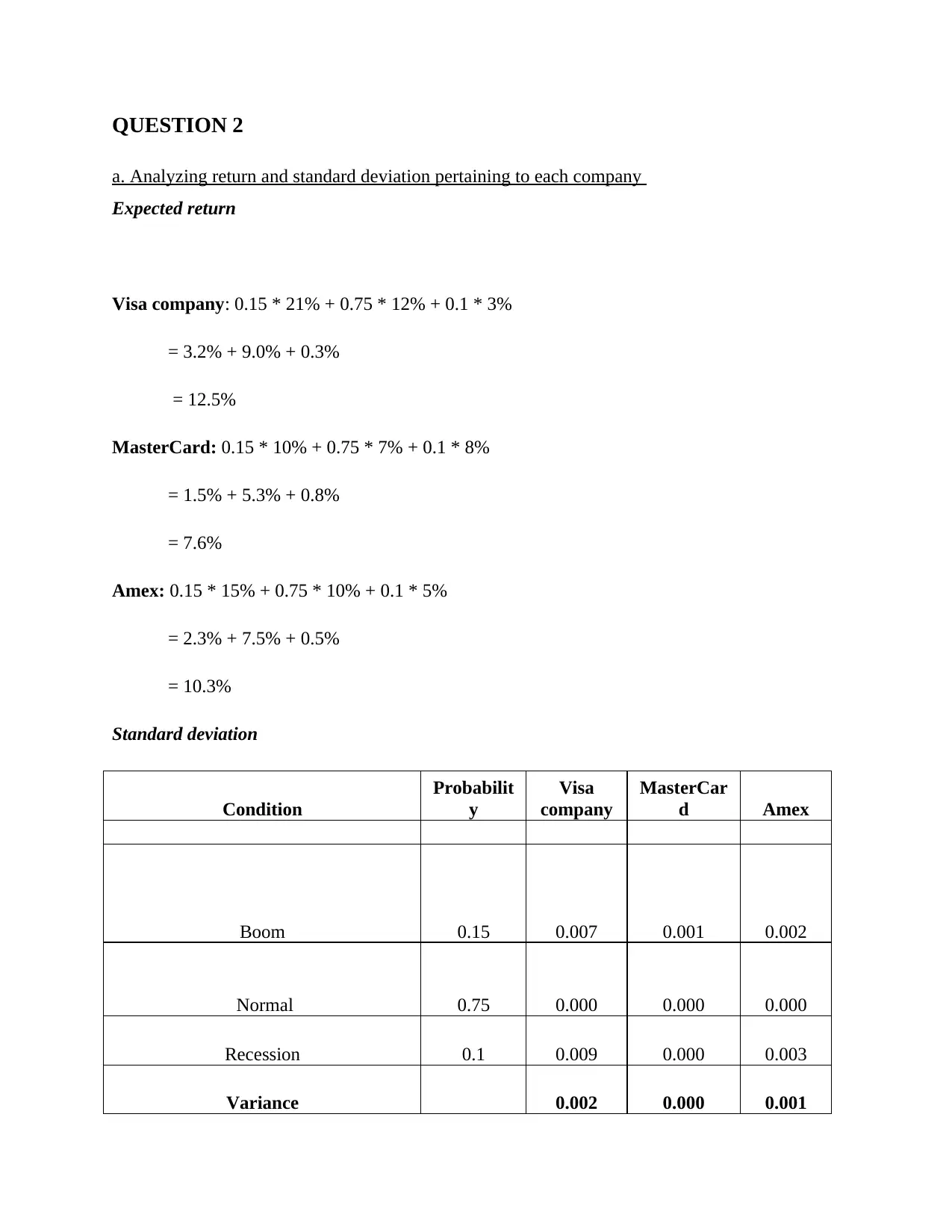
QUESTION 2
a. Analyzing return and standard deviation pertaining to each company
Expected return
Visa company: 0.15 * 21% + 0.75 * 12% + 0.1 * 3%
= 3.2% + 9.0% + 0.3%
= 12.5%
MasterCard: 0.15 * 10% + 0.75 * 7% + 0.1 * 8%
= 1.5% + 5.3% + 0.8%
= 7.6%
Amex: 0.15 * 15% + 0.75 * 10% + 0.1 * 5%
= 2.3% + 7.5% + 0.5%
= 10.3%
Standard deviation
Condition
Probabilit
y
Visa
company
MasterCar
d Amex
Boom 0.15 0.007 0.001 0.002
Normal 0.75 0.000 0.000 0.000
Recession 0.1 0.009 0.000 0.003
Variance 0.002 0.000 0.001
a. Analyzing return and standard deviation pertaining to each company
Expected return
Visa company: 0.15 * 21% + 0.75 * 12% + 0.1 * 3%
= 3.2% + 9.0% + 0.3%
= 12.5%
MasterCard: 0.15 * 10% + 0.75 * 7% + 0.1 * 8%
= 1.5% + 5.3% + 0.8%
= 7.6%
Amex: 0.15 * 15% + 0.75 * 10% + 0.1 * 5%
= 2.3% + 7.5% + 0.5%
= 10.3%
Standard deviation
Condition
Probabilit
y
Visa
company
MasterCar
d Amex
Boom 0.15 0.007 0.001 0.002
Normal 0.75 0.000 0.000 0.000
Recession 0.1 0.009 0.000 0.003
Variance 0.002 0.000 0.001
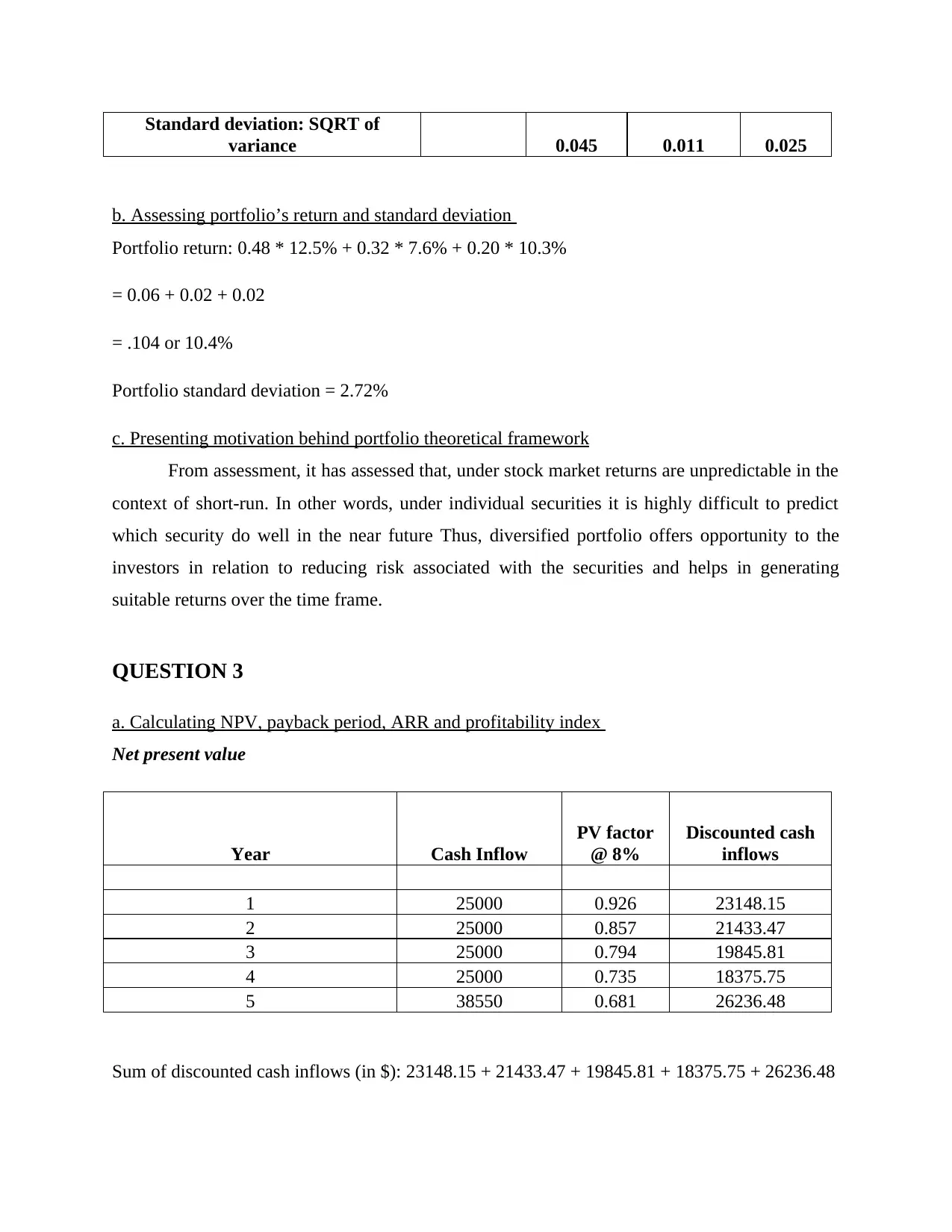
Standard deviation: SQRT of
variance 0.045 0.011 0.025
b. Assessing portfolio’s return and standard deviation
Portfolio return: 0.48 * 12.5% + 0.32 * 7.6% + 0.20 * 10.3%
= 0.06 + 0.02 + 0.02
= .104 or 10.4%
Portfolio standard deviation = 2.72%
c. Presenting motivation behind portfolio theoretical framework
From assessment, it has assessed that, under stock market returns are unpredictable in the
context of short-run. In other words, under individual securities it is highly difficult to predict
which security do well in the near future Thus, diversified portfolio offers opportunity to the
investors in relation to reducing risk associated with the securities and helps in generating
suitable returns over the time frame.
QUESTION 3
a. Calculating NPV, payback period, ARR and profitability index
Net present value
Year Cash Inflow
PV factor
@ 8%
Discounted cash
inflows
1 25000 0.926 23148.15
2 25000 0.857 21433.47
3 25000 0.794 19845.81
4 25000 0.735 18375.75
5 38550 0.681 26236.48
Sum of discounted cash inflows (in $): 23148.15 + 21433.47 + 19845.81 + 18375.75 + 26236.48
variance 0.045 0.011 0.025
b. Assessing portfolio’s return and standard deviation
Portfolio return: 0.48 * 12.5% + 0.32 * 7.6% + 0.20 * 10.3%
= 0.06 + 0.02 + 0.02
= .104 or 10.4%
Portfolio standard deviation = 2.72%
c. Presenting motivation behind portfolio theoretical framework
From assessment, it has assessed that, under stock market returns are unpredictable in the
context of short-run. In other words, under individual securities it is highly difficult to predict
which security do well in the near future Thus, diversified portfolio offers opportunity to the
investors in relation to reducing risk associated with the securities and helps in generating
suitable returns over the time frame.
QUESTION 3
a. Calculating NPV, payback period, ARR and profitability index
Net present value
Year Cash Inflow
PV factor
@ 8%
Discounted cash
inflows
1 25000 0.926 23148.15
2 25000 0.857 21433.47
3 25000 0.794 19845.81
4 25000 0.735 18375.75
5 38550 0.681 26236.48
Sum of discounted cash inflows (in $): 23148.15 + 21433.47 + 19845.81 + 18375.75 + 26236.48
Secure Best Marks with AI Grader
Need help grading? Try our AI Grader for instant feedback on your assignments.
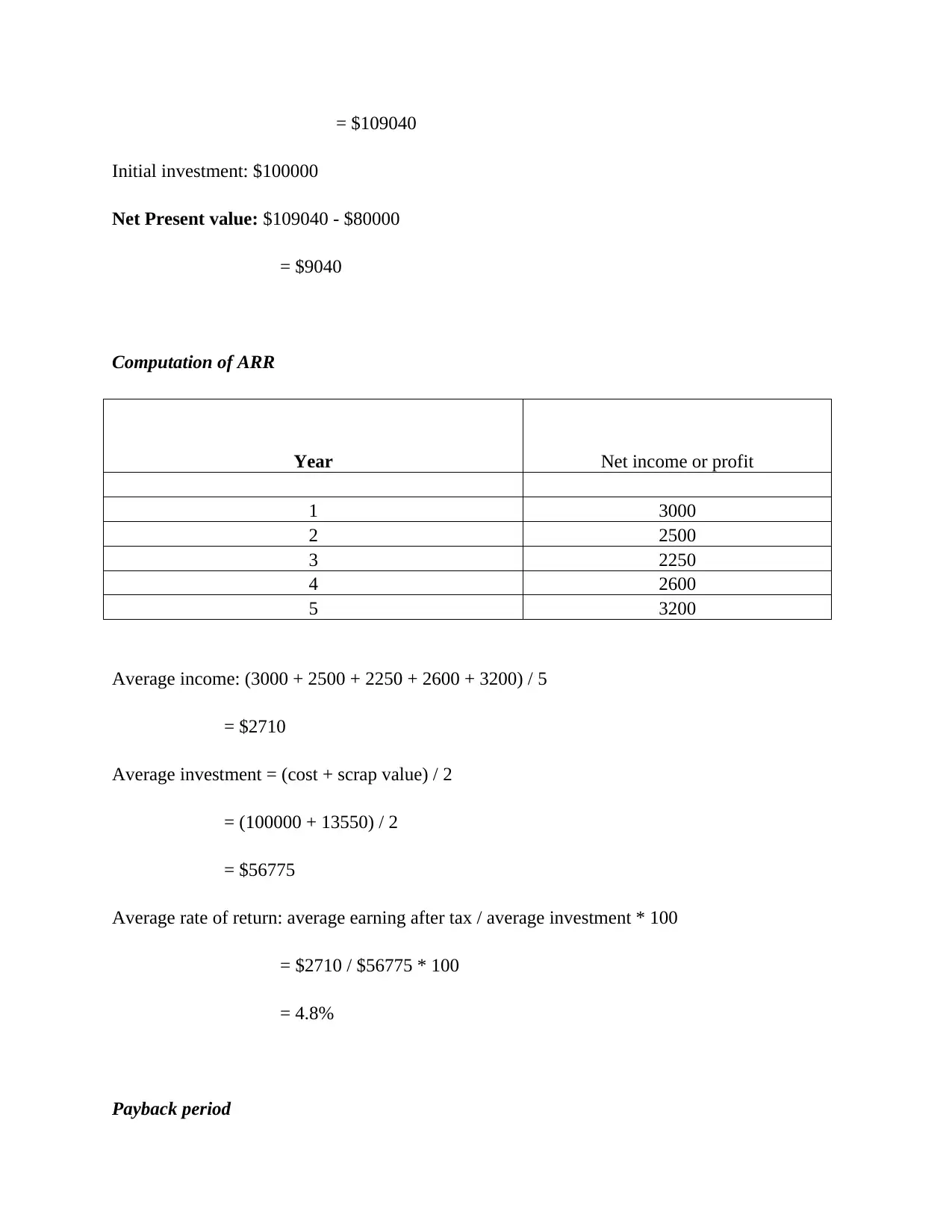
= $109040
Initial investment: $100000
Net Present value: $109040 - $80000
= $9040
Computation of ARR
Year Net income or profit
1 3000
2 2500
3 2250
4 2600
5 3200
Average income: (3000 + 2500 + 2250 + 2600 + 3200) / 5
= $2710
Average investment = (cost + scrap value) / 2
= (100000 + 13550) / 2
= $56775
Average rate of return: average earning after tax / average investment * 100
= $2710 / $56775 * 100
= 4.8%
Payback period
Initial investment: $100000
Net Present value: $109040 - $80000
= $9040
Computation of ARR
Year Net income or profit
1 3000
2 2500
3 2250
4 2600
5 3200
Average income: (3000 + 2500 + 2250 + 2600 + 3200) / 5
= $2710
Average investment = (cost + scrap value) / 2
= (100000 + 13550) / 2
= $56775
Average rate of return: average earning after tax / average investment * 100
= $2710 / $56775 * 100
= 4.8%
Payback period
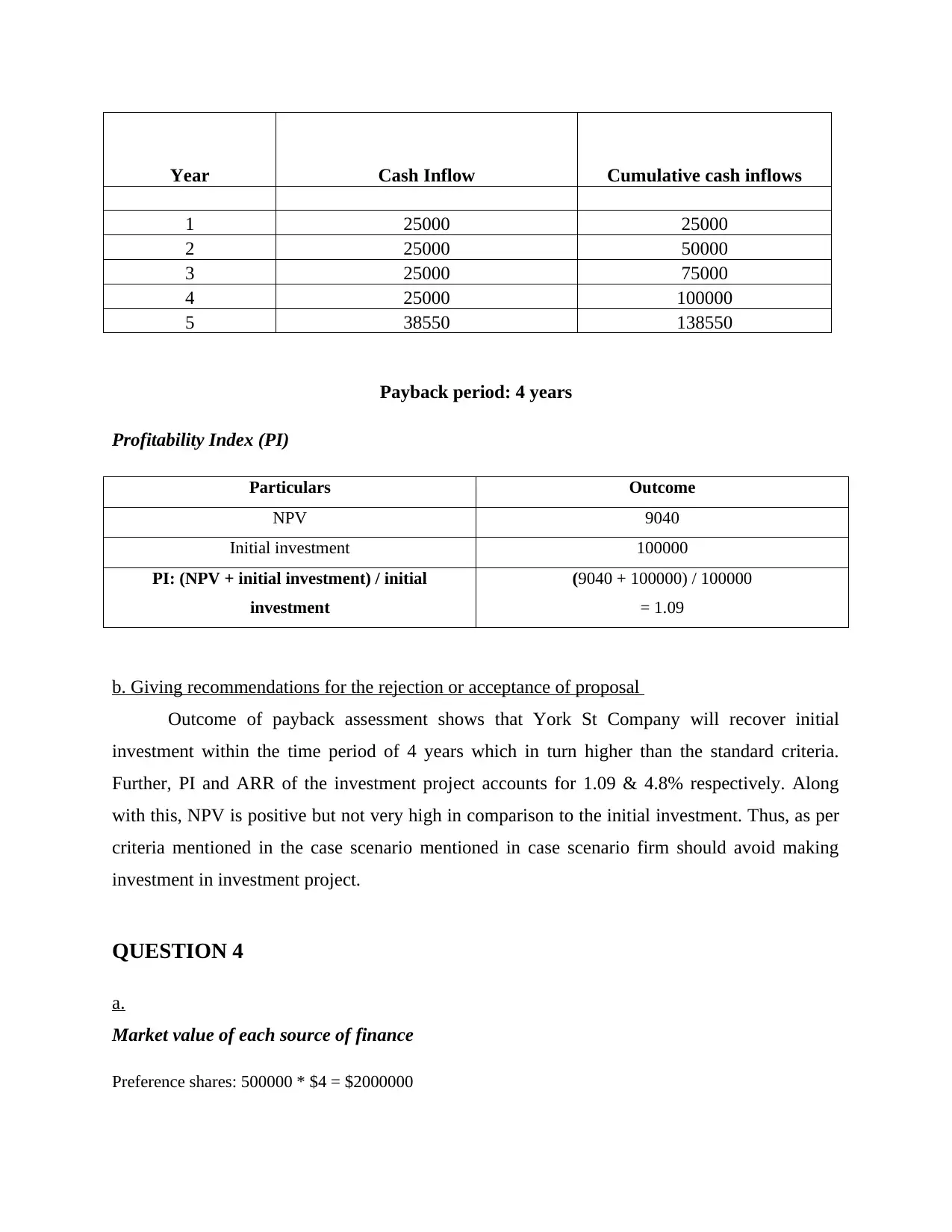
Year Cash Inflow Cumulative cash inflows
1 25000 25000
2 25000 50000
3 25000 75000
4 25000 100000
5 38550 138550
Payback period: 4 years
Profitability Index (PI)
Particulars Outcome
NPV 9040
Initial investment 100000
PI: (NPV + initial investment) / initial
investment
(9040 + 100000) / 100000
= 1.09
b. Giving recommendations for the rejection or acceptance of proposal
Outcome of payback assessment shows that York St Company will recover initial
investment within the time period of 4 years which in turn higher than the standard criteria.
Further, PI and ARR of the investment project accounts for 1.09 & 4.8% respectively. Along
with this, NPV is positive but not very high in comparison to the initial investment. Thus, as per
criteria mentioned in the case scenario mentioned in case scenario firm should avoid making
investment in investment project.
QUESTION 4
a.
Market value of each source of finance
Preference shares: 500000 * $4 = $2000000
1 25000 25000
2 25000 50000
3 25000 75000
4 25000 100000
5 38550 138550
Payback period: 4 years
Profitability Index (PI)
Particulars Outcome
NPV 9040
Initial investment 100000
PI: (NPV + initial investment) / initial
investment
(9040 + 100000) / 100000
= 1.09
b. Giving recommendations for the rejection or acceptance of proposal
Outcome of payback assessment shows that York St Company will recover initial
investment within the time period of 4 years which in turn higher than the standard criteria.
Further, PI and ARR of the investment project accounts for 1.09 & 4.8% respectively. Along
with this, NPV is positive but not very high in comparison to the initial investment. Thus, as per
criteria mentioned in the case scenario mentioned in case scenario firm should avoid making
investment in investment project.
QUESTION 4
a.
Market value of each source of finance
Preference shares: 500000 * $4 = $2000000

Ordinary shares: 10000000 * $3.90 = $39000000
Debentures: $20000000
b.
@ Book value
Preference shares: 5 / 40 * 100
= 13%
Ordinary shares: 15 / 40 * 100
= 38%
Debentures: 20 / 40 * 100
= 50%
Particulars Figures (in $ millions) Weight
Preference shares 5 13%
Ordinary shares 15 38%
Debentures 20 50%
Total 40 100%
@ Market value
Preference shares: 2000000 / 61000000 * 100
= 3%
Ordinary shares: 39000000 / 61000000 * 100
= 64%
Debentures: 20000000 / 61000000 * 100
= 33%
Debentures: $20000000
b.
@ Book value
Preference shares: 5 / 40 * 100
= 13%
Ordinary shares: 15 / 40 * 100
= 38%
Debentures: 20 / 40 * 100
= 50%
Particulars Figures (in $ millions) Weight
Preference shares 5 13%
Ordinary shares 15 38%
Debentures 20 50%
Total 40 100%
@ Market value
Preference shares: 2000000 / 61000000 * 100
= 3%
Ordinary shares: 39000000 / 61000000 * 100
= 64%
Debentures: 20000000 / 61000000 * 100
= 33%
Paraphrase This Document
Need a fresh take? Get an instant paraphrase of this document with our AI Paraphraser
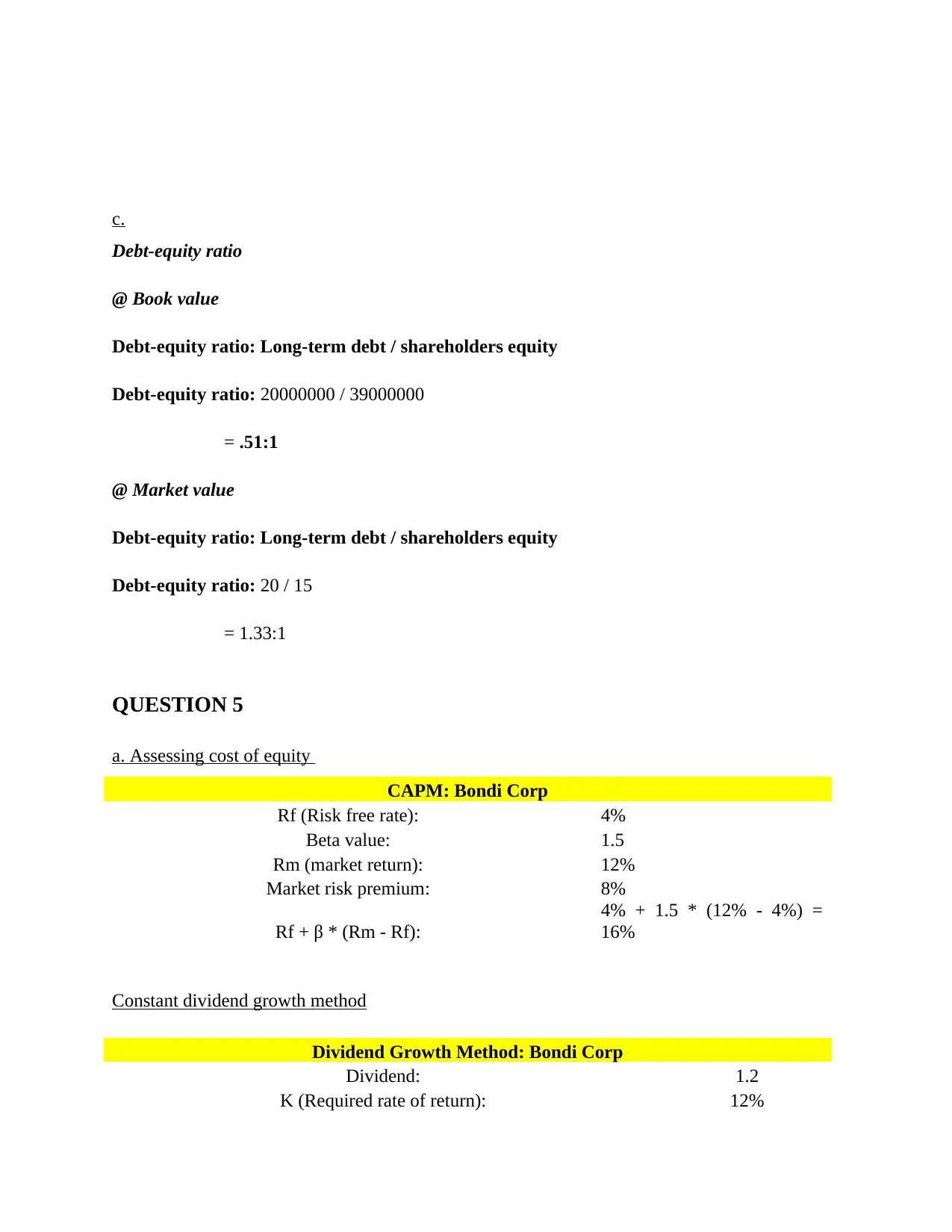
c.
Debt-equity ratio
@ Book value
Debt-equity ratio: Long-term debt / shareholders equity
Debt-equity ratio: 20000000 / 39000000
= .51:1
@ Market value
Debt-equity ratio: Long-term debt / shareholders equity
Debt-equity ratio: 20 / 15
= 1.33:1
QUESTION 5
a. Assessing cost of equity
CAPM: Bondi Corp
Rf (Risk free rate): 4%
Beta value: 1.5
Rm (market return): 12%
Market risk premium: 8%
Rf + β * (Rm - Rf):
4% + 1.5 * (12% - 4%) =
16%
Constant dividend growth method
Dividend Growth Method: Bondi Corp
Dividend: 1.2
K (Required rate of return): 12%
Debt-equity ratio
@ Book value
Debt-equity ratio: Long-term debt / shareholders equity
Debt-equity ratio: 20000000 / 39000000
= .51:1
@ Market value
Debt-equity ratio: Long-term debt / shareholders equity
Debt-equity ratio: 20 / 15
= 1.33:1
QUESTION 5
a. Assessing cost of equity
CAPM: Bondi Corp
Rf (Risk free rate): 4%
Beta value: 1.5
Rm (market return): 12%
Market risk premium: 8%
Rf + β * (Rm - Rf):
4% + 1.5 * (12% - 4%) =
16%
Constant dividend growth method
Dividend Growth Method: Bondi Corp
Dividend: 1.2
K (Required rate of return): 12%
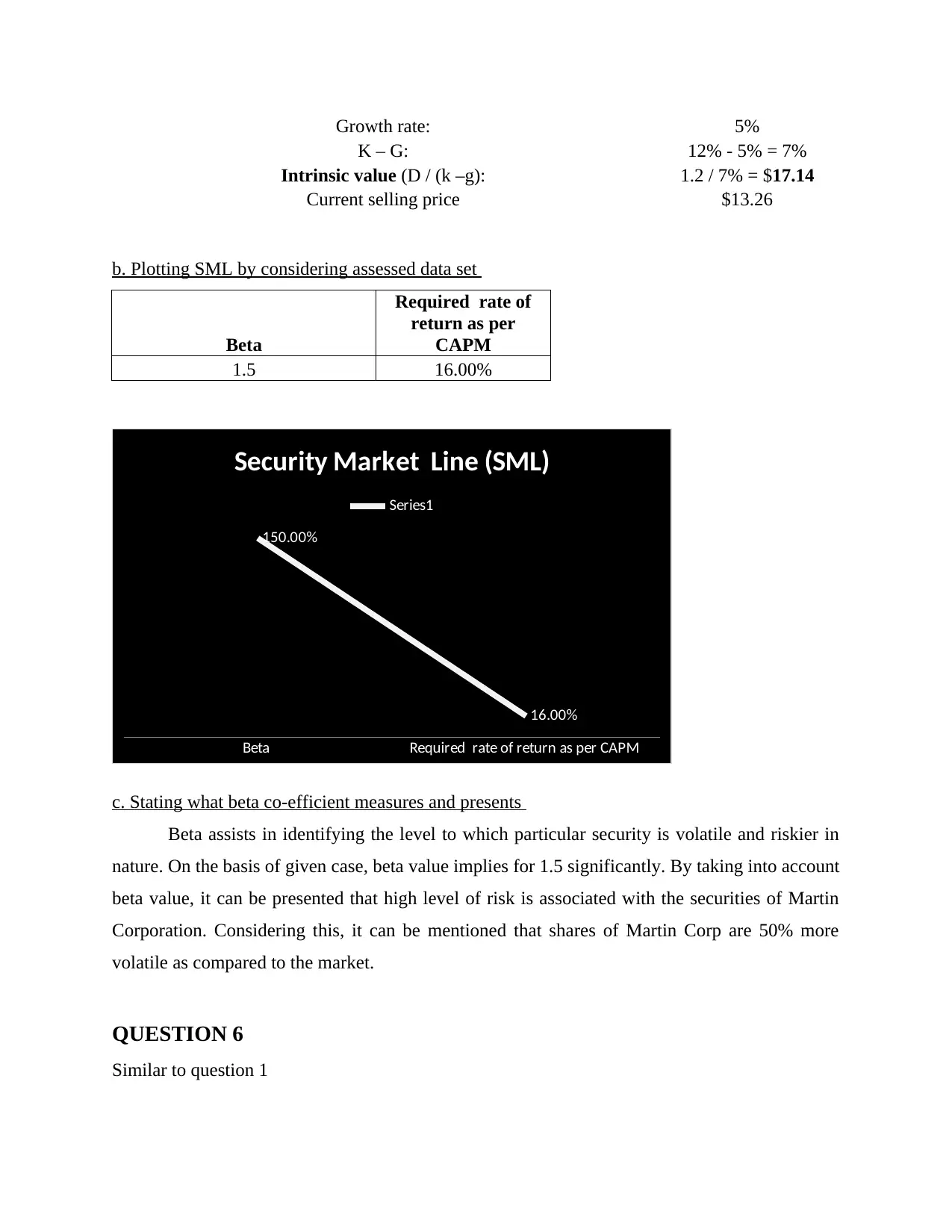
Growth rate: 5%
K – G: 12% - 5% = 7%
Intrinsic value (D / (k –g): 1.2 / 7% = $17.14
Current selling price $13.26
b. Plotting SML by considering assessed data set
Beta
Required rate of
return as per
CAPM
1.5 16.00%
Beta Required rate of return as per CAPM
150.00%
16.00%
Security Market Line (SML)
Series1
c. Stating what beta co-efficient measures and presents
Beta assists in identifying the level to which particular security is volatile and riskier in
nature. On the basis of given case, beta value implies for 1.5 significantly. By taking into account
beta value, it can be presented that high level of risk is associated with the securities of Martin
Corporation. Considering this, it can be mentioned that shares of Martin Corp are 50% more
volatile as compared to the market.
QUESTION 6
Similar to question 1
K – G: 12% - 5% = 7%
Intrinsic value (D / (k –g): 1.2 / 7% = $17.14
Current selling price $13.26
b. Plotting SML by considering assessed data set
Beta
Required rate of
return as per
CAPM
1.5 16.00%
Beta Required rate of return as per CAPM
150.00%
16.00%
Security Market Line (SML)
Series1
c. Stating what beta co-efficient measures and presents
Beta assists in identifying the level to which particular security is volatile and riskier in
nature. On the basis of given case, beta value implies for 1.5 significantly. By taking into account
beta value, it can be presented that high level of risk is associated with the securities of Martin
Corporation. Considering this, it can be mentioned that shares of Martin Corp are 50% more
volatile as compared to the market.
QUESTION 6
Similar to question 1
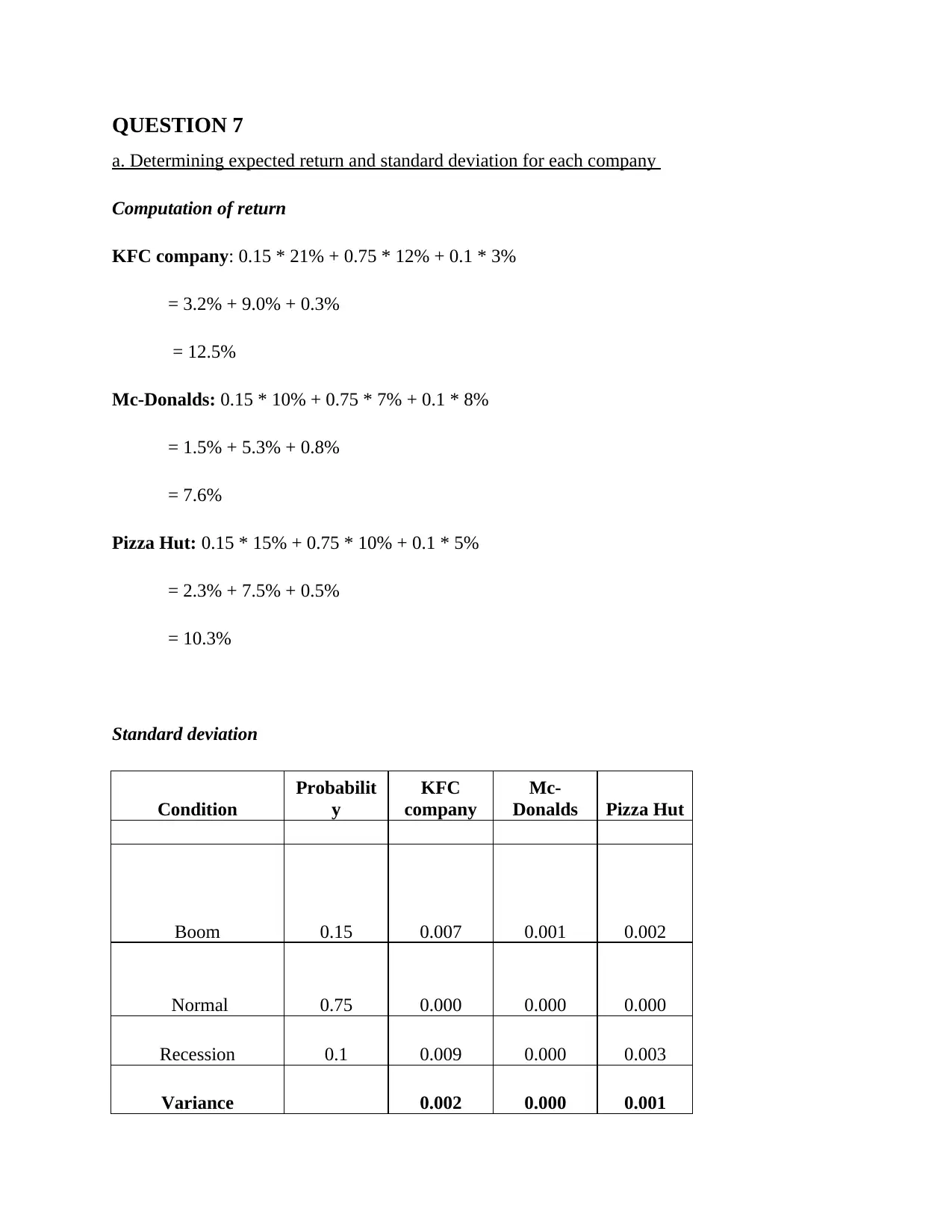
QUESTION 7
a. Determining expected return and standard deviation for each company
Computation of return
KFC company: 0.15 * 21% + 0.75 * 12% + 0.1 * 3%
= 3.2% + 9.0% + 0.3%
= 12.5%
Mc-Donalds: 0.15 * 10% + 0.75 * 7% + 0.1 * 8%
= 1.5% + 5.3% + 0.8%
= 7.6%
Pizza Hut: 0.15 * 15% + 0.75 * 10% + 0.1 * 5%
= 2.3% + 7.5% + 0.5%
= 10.3%
Standard deviation
Condition
Probabilit
y
KFC
company
Mc-
Donalds Pizza Hut
Boom 0.15 0.007 0.001 0.002
Normal 0.75 0.000 0.000 0.000
Recession 0.1 0.009 0.000 0.003
Variance 0.002 0.000 0.001
a. Determining expected return and standard deviation for each company
Computation of return
KFC company: 0.15 * 21% + 0.75 * 12% + 0.1 * 3%
= 3.2% + 9.0% + 0.3%
= 12.5%
Mc-Donalds: 0.15 * 10% + 0.75 * 7% + 0.1 * 8%
= 1.5% + 5.3% + 0.8%
= 7.6%
Pizza Hut: 0.15 * 15% + 0.75 * 10% + 0.1 * 5%
= 2.3% + 7.5% + 0.5%
= 10.3%
Standard deviation
Condition
Probabilit
y
KFC
company
Mc-
Donalds Pizza Hut
Boom 0.15 0.007 0.001 0.002
Normal 0.75 0.000 0.000 0.000
Recession 0.1 0.009 0.000 0.003
Variance 0.002 0.000 0.001
Secure Best Marks with AI Grader
Need help grading? Try our AI Grader for instant feedback on your assignments.
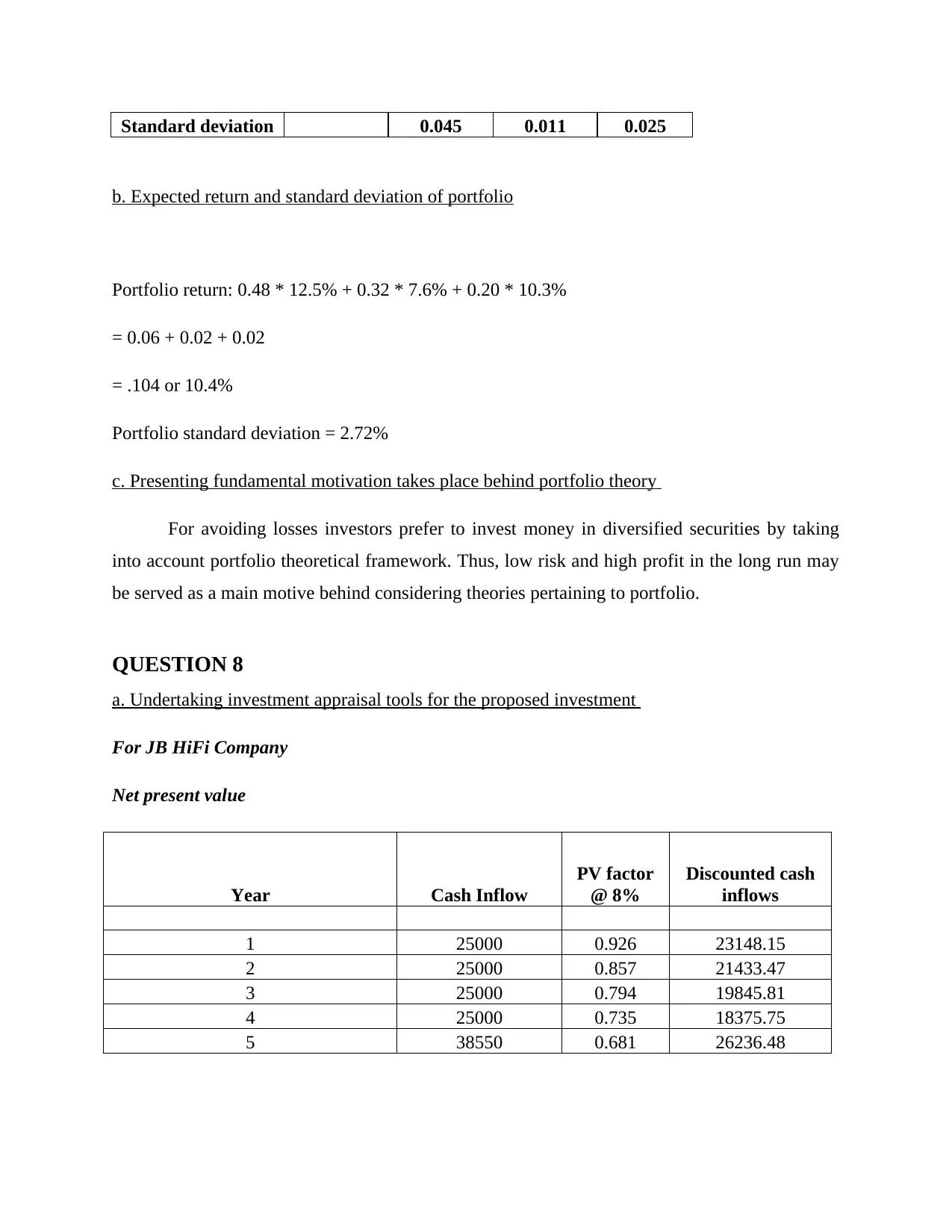
Standard deviation 0.045 0.011 0.025
b. Expected return and standard deviation of portfolio
Portfolio return: 0.48 * 12.5% + 0.32 * 7.6% + 0.20 * 10.3%
= 0.06 + 0.02 + 0.02
= .104 or 10.4%
Portfolio standard deviation = 2.72%
c. Presenting fundamental motivation takes place behind portfolio theory
For avoiding losses investors prefer to invest money in diversified securities by taking
into account portfolio theoretical framework. Thus, low risk and high profit in the long run may
be served as a main motive behind considering theories pertaining to portfolio.
QUESTION 8
a. Undertaking investment appraisal tools for the proposed investment
For JB HiFi Company
Net present value
Year Cash Inflow
PV factor
@ 8%
Discounted cash
inflows
1 25000 0.926 23148.15
2 25000 0.857 21433.47
3 25000 0.794 19845.81
4 25000 0.735 18375.75
5 38550 0.681 26236.48
b. Expected return and standard deviation of portfolio
Portfolio return: 0.48 * 12.5% + 0.32 * 7.6% + 0.20 * 10.3%
= 0.06 + 0.02 + 0.02
= .104 or 10.4%
Portfolio standard deviation = 2.72%
c. Presenting fundamental motivation takes place behind portfolio theory
For avoiding losses investors prefer to invest money in diversified securities by taking
into account portfolio theoretical framework. Thus, low risk and high profit in the long run may
be served as a main motive behind considering theories pertaining to portfolio.
QUESTION 8
a. Undertaking investment appraisal tools for the proposed investment
For JB HiFi Company
Net present value
Year Cash Inflow
PV factor
@ 8%
Discounted cash
inflows
1 25000 0.926 23148.15
2 25000 0.857 21433.47
3 25000 0.794 19845.81
4 25000 0.735 18375.75
5 38550 0.681 26236.48
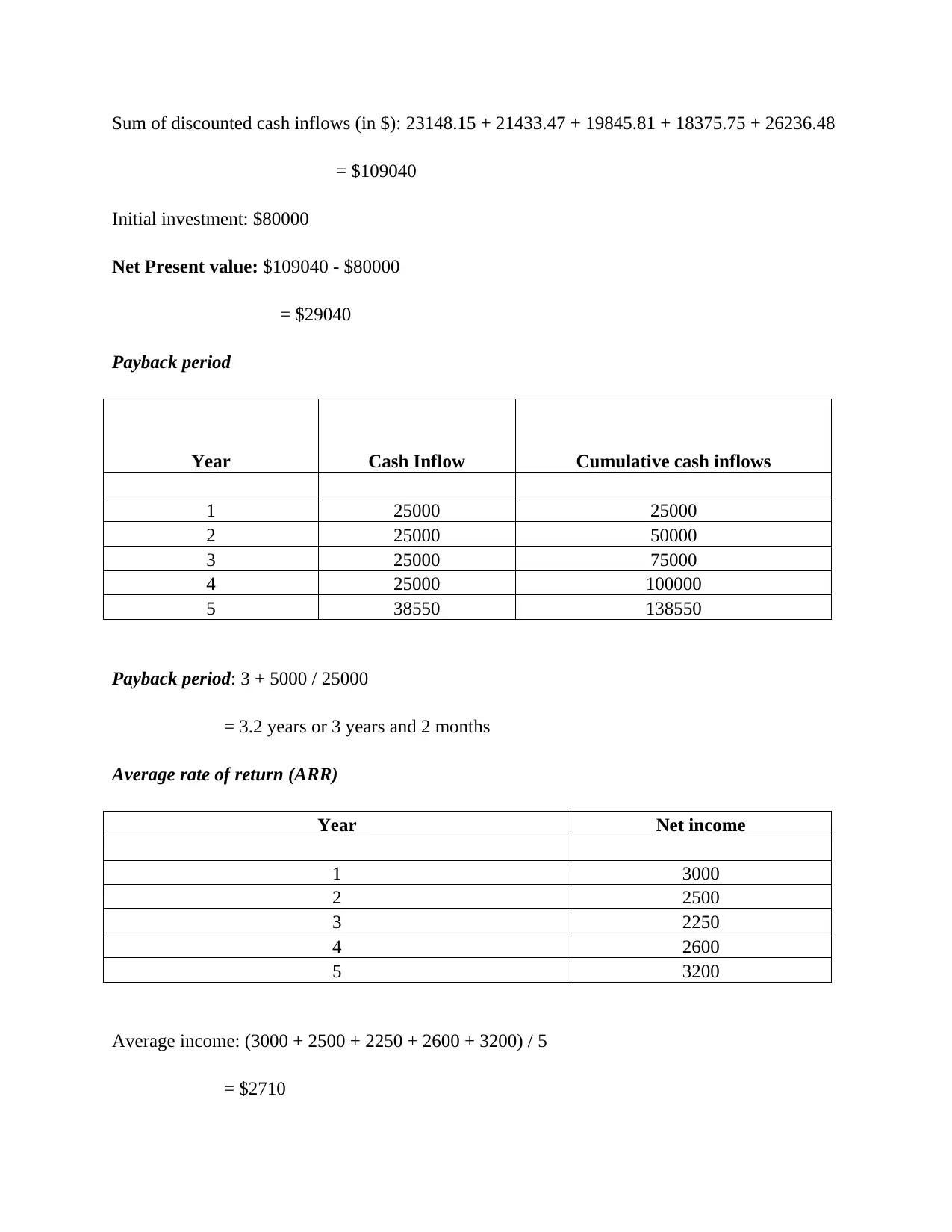
Sum of discounted cash inflows (in $): 23148.15 + 21433.47 + 19845.81 + 18375.75 + 26236.48
= $109040
Initial investment: $80000
Net Present value: $109040 - $80000
= $29040
Payback period
Year Cash Inflow Cumulative cash inflows
1 25000 25000
2 25000 50000
3 25000 75000
4 25000 100000
5 38550 138550
Payback period: 3 + 5000 / 25000
= 3.2 years or 3 years and 2 months
Average rate of return (ARR)
Year Net income
1 3000
2 2500
3 2250
4 2600
5 3200
Average income: (3000 + 2500 + 2250 + 2600 + 3200) / 5
= $2710
= $109040
Initial investment: $80000
Net Present value: $109040 - $80000
= $29040
Payback period
Year Cash Inflow Cumulative cash inflows
1 25000 25000
2 25000 50000
3 25000 75000
4 25000 100000
5 38550 138550
Payback period: 3 + 5000 / 25000
= 3.2 years or 3 years and 2 months
Average rate of return (ARR)
Year Net income
1 3000
2 2500
3 2250
4 2600
5 3200
Average income: (3000 + 2500 + 2250 + 2600 + 3200) / 5
= $2710
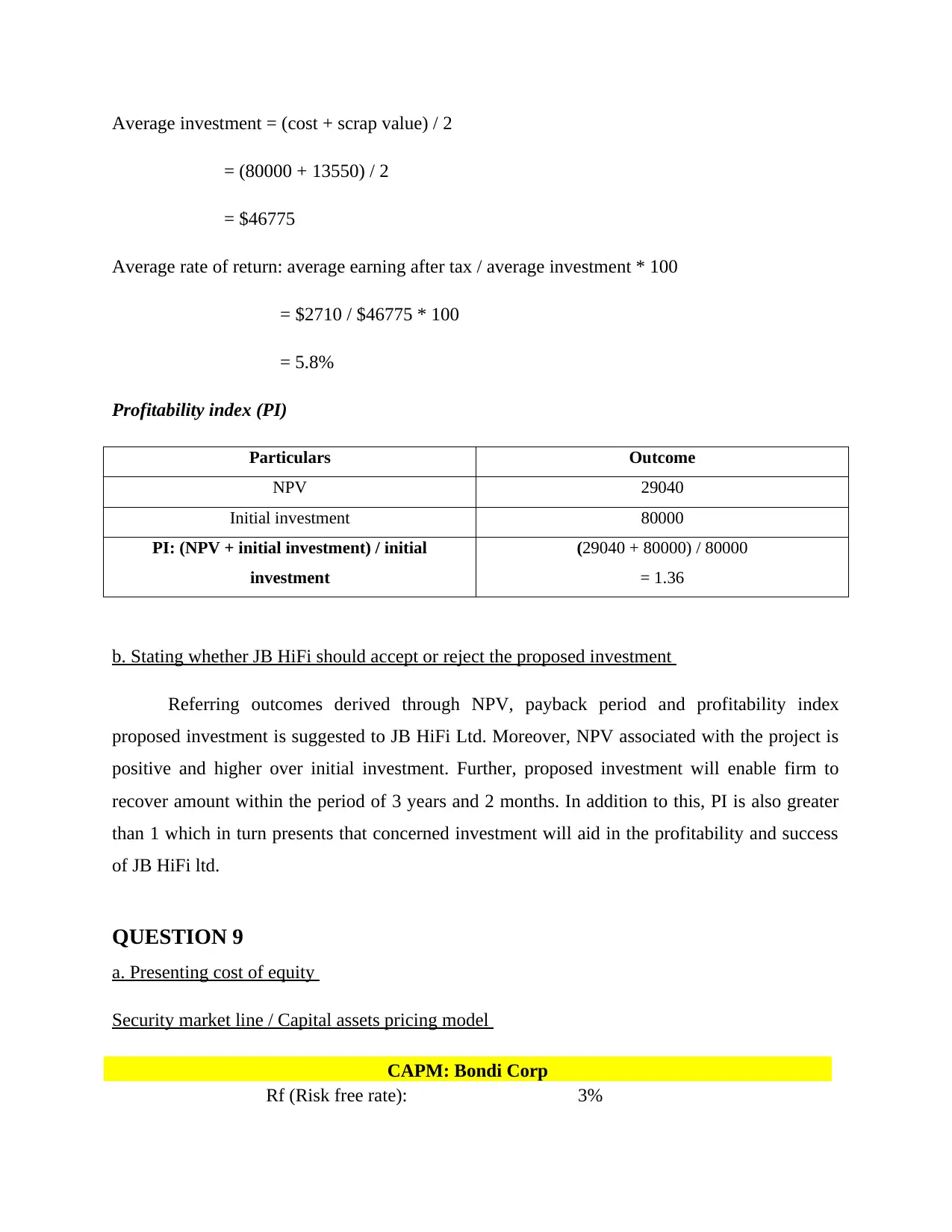
Average investment = (cost + scrap value) / 2
= (80000 + 13550) / 2
= $46775
Average rate of return: average earning after tax / average investment * 100
= $2710 / $46775 * 100
= 5.8%
Profitability index (PI)
Particulars Outcome
NPV 29040
Initial investment 80000
PI: (NPV + initial investment) / initial
investment
(29040 + 80000) / 80000
= 1.36
b. Stating whether JB HiFi should accept or reject the proposed investment
Referring outcomes derived through NPV, payback period and profitability index
proposed investment is suggested to JB HiFi Ltd. Moreover, NPV associated with the project is
positive and higher over initial investment. Further, proposed investment will enable firm to
recover amount within the period of 3 years and 2 months. In addition to this, PI is also greater
than 1 which in turn presents that concerned investment will aid in the profitability and success
of JB HiFi ltd.
QUESTION 9
a. Presenting cost of equity
Security market line / Capital assets pricing model
CAPM: Bondi Corp
Rf (Risk free rate): 3%
= (80000 + 13550) / 2
= $46775
Average rate of return: average earning after tax / average investment * 100
= $2710 / $46775 * 100
= 5.8%
Profitability index (PI)
Particulars Outcome
NPV 29040
Initial investment 80000
PI: (NPV + initial investment) / initial
investment
(29040 + 80000) / 80000
= 1.36
b. Stating whether JB HiFi should accept or reject the proposed investment
Referring outcomes derived through NPV, payback period and profitability index
proposed investment is suggested to JB HiFi Ltd. Moreover, NPV associated with the project is
positive and higher over initial investment. Further, proposed investment will enable firm to
recover amount within the period of 3 years and 2 months. In addition to this, PI is also greater
than 1 which in turn presents that concerned investment will aid in the profitability and success
of JB HiFi ltd.
QUESTION 9
a. Presenting cost of equity
Security market line / Capital assets pricing model
CAPM: Bondi Corp
Rf (Risk free rate): 3%
Paraphrase This Document
Need a fresh take? Get an instant paraphrase of this document with our AI Paraphraser
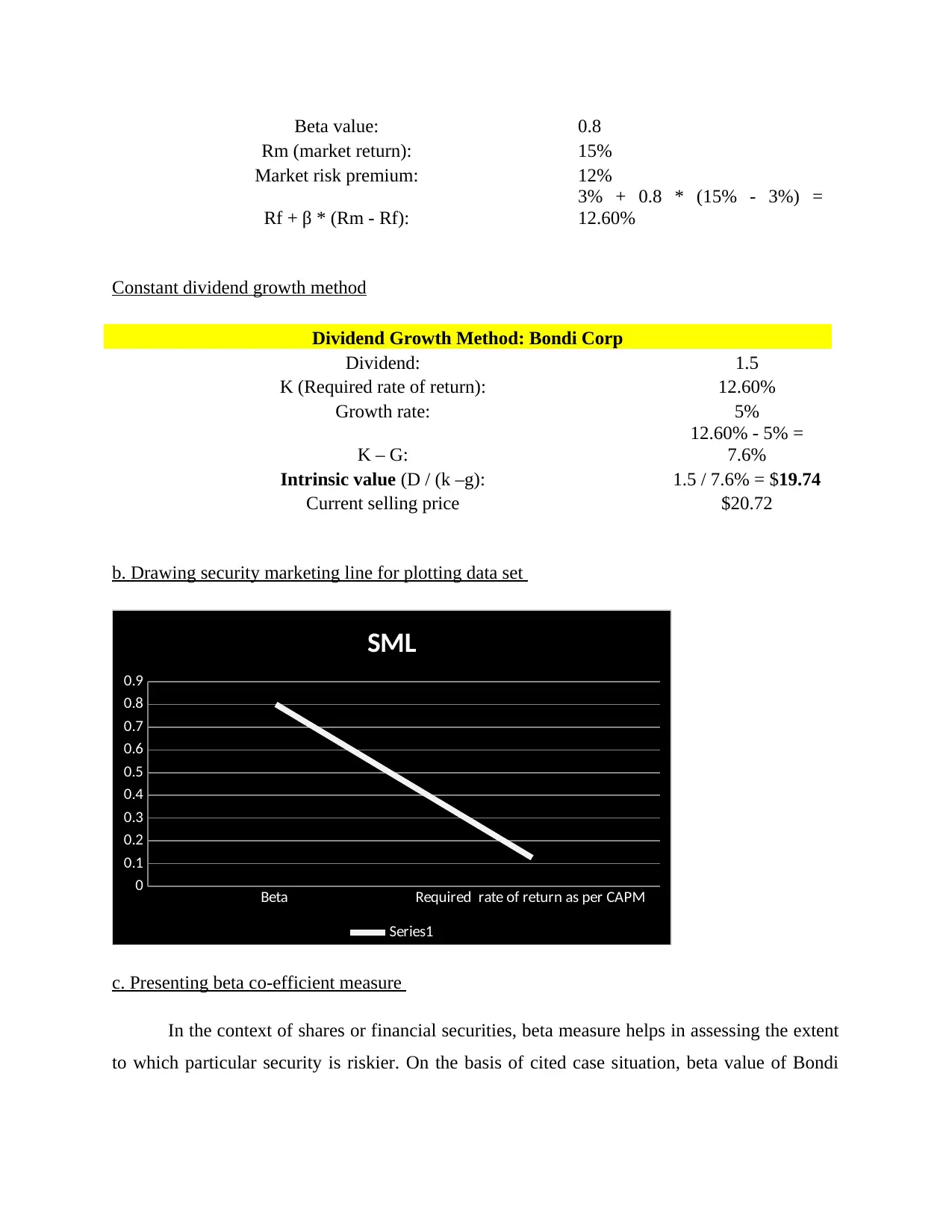
Beta value: 0.8
Rm (market return): 15%
Market risk premium: 12%
Rf + β * (Rm - Rf):
3% + 0.8 * (15% - 3%) =
12.60%
Constant dividend growth method
Dividend Growth Method: Bondi Corp
Dividend: 1.5
K (Required rate of return): 12.60%
Growth rate: 5%
K – G:
12.60% - 5% =
7.6%
Intrinsic value (D / (k –g): 1.5 / 7.6% = $19.74
Current selling price $20.72
b. Drawing security marketing line for plotting data set
Beta Required rate of return as per CAPM
0
0.1
0.2
0.3
0.4
0.5
0.6
0.7
0.8
0.9
SML
Series1
c. Presenting beta co-efficient measure
In the context of shares or financial securities, beta measure helps in assessing the extent
to which particular security is riskier. On the basis of cited case situation, beta value of Bondi
Rm (market return): 15%
Market risk premium: 12%
Rf + β * (Rm - Rf):
3% + 0.8 * (15% - 3%) =
12.60%
Constant dividend growth method
Dividend Growth Method: Bondi Corp
Dividend: 1.5
K (Required rate of return): 12.60%
Growth rate: 5%
K – G:
12.60% - 5% =
7.6%
Intrinsic value (D / (k –g): 1.5 / 7.6% = $19.74
Current selling price $20.72
b. Drawing security marketing line for plotting data set
Beta Required rate of return as per CAPM
0
0.1
0.2
0.3
0.4
0.5
0.6
0.7
0.8
0.9
SML
Series1
c. Presenting beta co-efficient measure
In the context of shares or financial securities, beta measure helps in assessing the extent
to which particular security is riskier. On the basis of cited case situation, beta value of Bondi
1 out of 14
Your All-in-One AI-Powered Toolkit for Academic Success.
+13062052269
info@desklib.com
Available 24*7 on WhatsApp / Email
![[object Object]](/_next/static/media/star-bottom.7253800d.svg)
Unlock your academic potential
© 2024 | Zucol Services PVT LTD | All rights reserved.